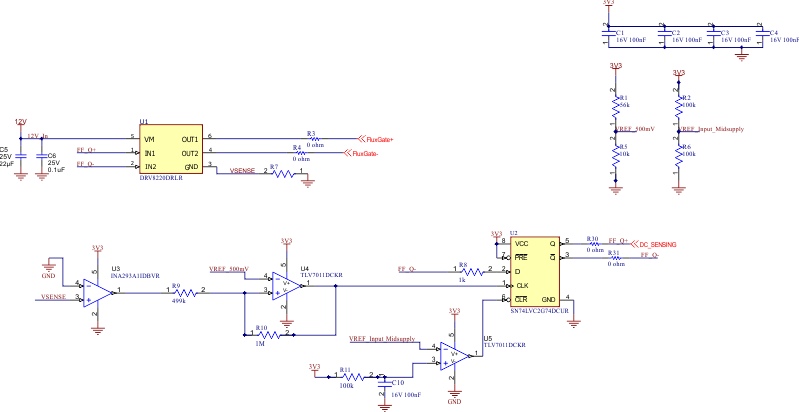TIDUF03 December 2022
- Description
- Resources
- Features
- Applications
- 5
- 1System Description
- 2System Overview
-
3Hardware, Software, Testing Requirements, and Test Results
- 3.1
Hardware
- 3.1.1 Board Overview
- 3.1.2 Filter Stage
- 3.1.3 Differential to Single-Ended Converter
- 3.1.4 Low-Pass Filter
- 3.1.5 Full-Wave Rectifier
- 3.1.6 DC Offset Circuit
- 3.1.7 Auto-Oscillation Circuit
- 3.1.8 DRV8220 H-Bridge
- 3.1.9 Saturation Detection Circuit
- 3.1.10 H-Bridge Controlled by DFF
- 3.1.11 MCU Selection
- 3.1.12 Move Away From Timer Capture
- 3.1.13 Differentiating DC and AC From the Same Signal
- 3.1.14 Fluxgate Sensor
- 3.2 Software Requirements
- 3.3 Test Setup
- 3.4 Test Results
- 3.5 Fault Response Results
- 3.1
Hardware
- 4Design and Documentation Support
- 5About the Author
3.1.7 Auto-Oscillation Circuit
The Auto-Oscillation sub-circuit detects when the fluxgate sensor reaches saturation, then reverse the current direction. When saturation is reached, current sense voltage exceeds the comparator threshold, which causes the D-type flip-flop to flip control signals to the DRV8220 H-bridge. This drives the fluxgate sensor core to saturation in the opposite direction.
 Figure 3-11 Auto-Oscillation Circuit
Schematic
Figure 3-11 Auto-Oscillation Circuit
SchematicThis circuit monitors the current flowing through the fluxgate and reverses drive current direction once saturation is reached. The auto-oscillation circuit is needed to detect DC faults.
The phase lines and neutral wires go through a fluxgate sensor. During normal operation without a fault condition, the sum of currents equals zero.
During a ground fault condition, the sum of currents is not equal to zero. During a DC fault, there is an imbalance of current flowing through the line and current returning through the neutral wire. The fluxgate is blind to steady DC current. An oscillating drive current is pushed through the fluxgate sensor coil. This DC fault current produces a magnetic field which opposes fluxgate drive in one direction, and assists fluxgate drive in the opposite direction; resulting in a duty cycle shift. Under normal conditions, the duty cycle of the switching is 50%. During a DC fault, the duty cycle shifts.